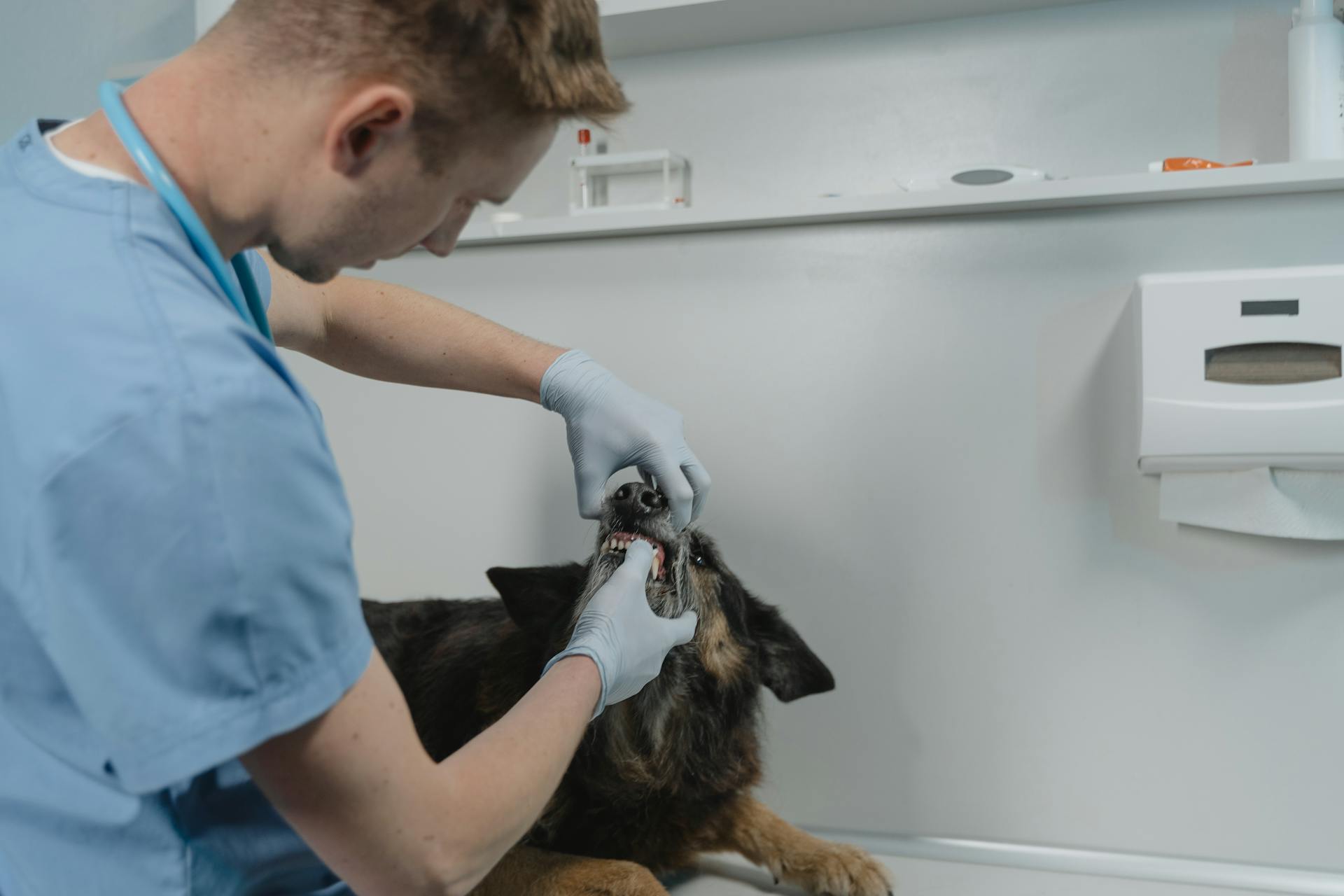
Hemangiosarcoma is a type of cancer that affects dogs, particularly those of certain breeds such as German Shepherds, Golden Retrievers, and Labrador Retrievers.
The prognosis for dogs with hemangiosarcoma is generally poor, with a median survival time of 1-3 months after diagnosis.
Unfortunately, the cancer often goes undetected until it's in an advanced stage, making treatment more challenging.
Symptoms may include weakness, weight loss, and difficulty breathing, which can be mistaken for other conditions.
What Is Hemangiosarcoma?
Hemangiosarcoma is a type of cancer that affects the blood vessels in dogs.
It's a highly malignant tumor, meaning it can spread quickly to other parts of the body, including the liver, spleen, and lymph nodes.
Hemangiosarcoma can arise from anywhere in the body, but it most commonly affects the spleen, accounting for about 75% of all cases.
The exact cause of hemangiosarcoma is still unknown, but it's believed to be linked to genetic mutations and environmental factors.
Hemangiosarcoma is a leading cause of death in older dogs, with the average age of diagnosis being around 10-14 years old.
Symptoms can vary depending on the location and size of the tumor, but common signs include weakness, weight loss, and pale gums.
A different take: Canine Hemangiosarcoma Spleen
Symptoms and Diagnosis

Symptoms of hemangiosarcoma in dogs can be quite subtle, especially in the early stages of the disease, with common symptoms including lethargy, weakness, loss of appetite, weight loss, pale gums, abdominal swelling, and difficulty breathing.
Some dogs may experience fainting or weakness, lack of coordination, partial paralysis, intermittent collapse, seizures, and nosebleeds.
Internal HSAs can cause general signs of illness, such as lethargy, depression, and inappetence, which can be easily overlooked.
As the disease progresses, symptoms may become more acute, requiring emergency veterinary care.
Hemangiosarcoma can be challenging to diagnose, as there's no test to definitively diagnose the disease.
Veterinarians typically run blood tests to check for anemia, which is a common symptom of hemangiosarcoma.
Imaging tests like ultrasound and x-rays can be used to look for tumors, but a biopsy or aspirate of the tumor may be needed to confirm the diagnosis.
In some cases, the symptoms of hemangiosarcoma may appear and disappear, making it difficult for pet owners to recognize the disease.
Recommended read: Canine Lymphoma End of Life Symptoms
Diagnosis and Stages

Diagnosing hemangiosarcoma can be challenging because there's no test to definitively diagnose the disease.
Veterinarians typically run blood tests to check for anemia, which is a low red blood cell count. This is a common symptom of hemangiosarcoma.
Imaging tests such as ultrasound and x-rays can be used to look for tumors, which can help confirm the diagnosis.
A biopsy or aspirate of the tumor may be used to confirm the diagnosis in some cases.
The disease can be subtle in its early stages, making it difficult for pet owners to detect.
Suggestion: Can a Dog Have Cancer with Normal Blood Work
Treatment and Management
Surgery is often the preferred treatment for dogs with hemangiosarcoma because it can remove the tumor and surrounding tissue.
The goal of surgery is to help slow the spread of the disease, but unfortunately, it's not usually effective at curing hemangiosarcoma.
Chemotherapy may also be used to kill remaining cancer cells and prevent the cancer from spreading to other organs.
While surgery and chemotherapy can help prolong a dog's life, they are not a guarantee of a long life.
Treatment Options for Dogs

Treatment options for dogs with hemangiosarcoma depend on the location and size of the tumor, the extent of the disease, and the dog's overall health.
Surgery is often the preferred treatment because it can remove the tumor and surrounding tissue and help slow the spread.
Chemotherapy may also be used to kill remaining cancer cells and to prevent the cancer from spreading to other organs.
Unfortunately, surgery and chemotherapy may not be effective at curing hemangiosarcoma.
The prognosis for dogs with hemangiosarcoma is generally very poor, and the majority of dogs succumb to the disease within a few weeks or months of diagnosis.
Intriguing read: New Treatment for Canine Hemangiosarcoma
Managing Survival Times
Most dog owners don't really understand how short-lived dogs are, which can make it hard to accept the reality of their mortality.
It's common for people to forget that dogs will eventually die, even veterinarians.
Most dogs live about as long as their average lifespan would predict, with outliers being the exception.

To put survival times into perspective, consider your dog's age and breed.
If your dog is 8 and the average lifespan for his weight and breed is 10 years, a survival time of 18 months to two years is actually a relatively long time.
Veterinarians are not motivated to lie about outcomes, but rather provide a medical perspective on your dog's condition.
A different take: Hemangiosarcoma in Dogs Survival Rate
Prognosis and Life Expectancy
The prognosis for dogs with hemangiosarcoma is generally poor, especially when the disease is discovered at its early stages. Even with treatment, the long-term prognosis is dismal.
The survival rate for dogs with hemangiosarcoma varies depending on the location and stage of the disease. For example, dogs with dermal hemangiosarcoma that cannot be cured through treatment may survive for 5 to 10 months, while those with hypodermal HSA have an average survival time of 6 months.
Without treatment, most dogs diagnosed with hemangiosarcoma of the internal organs will die within one to two weeks, although some can survive for several months.
Broaden your view: Natural Remedies for Canine Lymphoma

The prognosis for dogs with splenic hemangiosarcoma treated with surgery alone is typically one to three months, while those treated with surgery and chemotherapy have an improved prognosis of four to eight months. However, if extensive metastasis is present at the time of surgery, survival time is only about two months when followed with chemotherapy.
Here are some general survival time estimates for dogs with hemangiosarcoma:
- Dogs with dermal HSA that cannot be cured through treatment: 5-10 months
- Dogs with hypodermal HSA: 6 months
- Dogs with splenic HSA treated with surgery alone: 1-3 months
- Dogs with splenic HSA treated with surgery and chemotherapy: 4-8 months
- Dogs with internal organ HSA: typically die within 1-2 weeks without treatment
Causes and Risk Factors
Hemangiosarcoma is a complex and multifaceted disease, and understanding its causes and risk factors can help us better grasp the challenges it poses for our furry friends.
Older dogs, particularly those over the age of 10, are more susceptible to hemangiosarcoma due to the natural aging process.
Some breeds, such as German Shepherds, Golden Retrievers, and Labrador Retrievers, are more prone to hemangiosarcoma than others, with German Shepherds being at the highest risk.
Genetic predisposition plays a significant role in the development of hemangiosarcoma, with certain genetic mutations increasing the likelihood of the disease.
Male dogs are more likely to develop hemangiosarcoma than female dogs, with a 3:2 male-to-female ratio observed in many studies.
Exposure to environmental toxins and carcinogens, such as pesticides and heavy metals, may also contribute to the development of hemangiosarcoma in dogs.
Additional reading: Hemangiosarcoma in German Shepherds
Frequently Asked Questions
Do dogs feel pain with hemangiosarcoma?
Dogs with hemangiosarcoma typically don't experience pain in its early stages. However, symptoms can develop over time, making it essential to monitor your dog's health closely.
When can I put my dog down with hemangiosarcoma?
You may consider euthanasia when your dog's bleeding is slow or non-existent, or after surgery to remove the splenic mass if they're declining. This decision often requires careful consideration and consultation with a veterinarian.
Has a dog ever beaten hemangiosarcoma?
Yes, a dog named Chase, a dachshund, has beaten hemangiosarcoma, a rare and aggressive cancer, exceeding all expectations
What are the final stages of hemangiosarcoma?
During the final stages of hemangiosarcoma, dogs may exhibit pale gums, rapid heart rate, and difficulty breathing due to the cancer's impact on their circulatory and respiratory systems. If you suspect your dog is experiencing these symptoms, seek veterinary care immediately to ensure the best possible quality of life.
How do you comfort a dog with hemangiosarcoma?
To comfort a dog with hemangiosarcoma, provide easily accessible food and water in a comfortable location, and monitor their health closely to prevent complications. Follow your veterinarian's guidance on medication, exercise, and care to ensure your dog's comfort and well-being.
Sources
- https://todaysveterinarypractice.com/news/can-we-find-a-cure-for-canine-hemangiosarcoma/
- https://www.whole-dog-journal.com/health/hemangiosarcoma-in-dogs/
- https://avmajournals.avma.org/abstract/journals/javma/248/11/javma.248.11.1267.xml
- https://www.tackletoughthings.com/blog/when-cancer-strikes-coping-with-a-hemangiosarcoma-diagnosis-in-your-dog
- https://www.dogcancerblog.com/articles/choosing-treatments/diagnosis/survival-times-and-dog-cancer/
Featured Images: pexels.com


